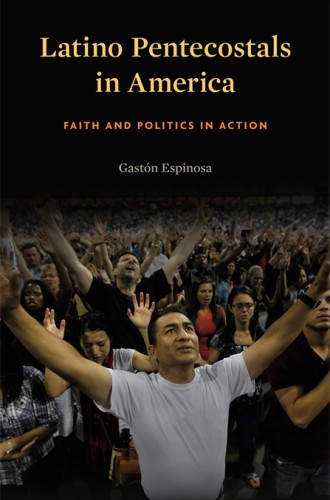Latino Pentecostals in America, by Gastón Espinosa
Histories of Pentecostalism in the United States have long focused on binary narratives of the development of African-American and white Pentecostalism out of the great revival at Azusa Street in Los Angeles. In recent years, scholars of Pentecostalism have expanded this narrative to include Latino and Native American Pentecostals—who were a part of the movement from the beginning. Gastón Espinosa’s Latino Pentecostals in America joins this trend, tracing the history of Latino involvement in the Assemblies of God and challenging long-standing narratives.
The book is actually more like three books in one. The first third of the book is devoted to the growth of Pentecostalism among Mexicans and Mexican-Americans in Texas and California. After that, Espinosa focuses on Puerto Ricans and the growth of Pentecostalism both on the island and in New York City. Then he addresses more recent issues among Latino Pentecostals, including the role of women in the church, faith and social activism, and political trends. The book hangs together as a self-conscious rewrite of Assemblies of God history that privileges the Latino voices that have so often been left out of denominational narratives.
Read our latest issue or browse back issues.
Espinosa, an associate professor of religious studies at Claremont McKenna College, has written about early Latino Pentecostals in California and Texas in previous articles and essays, and his depth of knowledge shows here. He stresses the importance of Azusa Street minister William Seymour’s radical theology of racial equality, showing that it was important not only for African-American church growth, but also for the development of early Latino Pentecostal leadership. When discussing the early development of Latino churches, he moves the spotlight from white missionaries to Latino leaders who in previous histories have usually been mentioned only in passing. He presents Francisco Olazábal, the famous Mexican preacher who tangled with white Assemblies of God leaders for control of Latino churches in southern Texas, as a central character in the development of Latino Pentecostalism in the Southwest, and indeed among Latinos nationwide.
Even though Espinosa moves white Assemblies of God missionaries to the sidelines in his narrative, he is fair in his treatment of them. In fine detail, he describes the fight among Olazábal, Henry Ball, and the white Assemblies leadership over the creation of a Latino district, explaining the motivations on all sides and the ramifications of their actions. Drawing on often overlooked sources, he discusses the importance of Pentecostal education in developing indigenous leadership. Espinosa does the same when he moves from Mexican and Mexican-American Pentecostals to Puerto Ricans, carefully addressing leadership both on the island and in New York City, describing how the islanders build indigenous churches, and explaining how urban Puerto Rican Pentecostals learned how to be flexible and ecumenical in dealing with the New York City religious marketplace.
In last third of the book, Espinosa brings the story of Latino Pentecostals up to date in a sociological manner by exploring topics such as women in ministry, political activism, immigration, involvement in the 2012 presidential election, and the influence of Pentecostals on Chicano labor leader Cesar Chavez. Although this section is fascinating, it seems in many ways almost a separate book. If Espinosa had written two books, he could have developed the sociological discussion more fully.
The title of the book does not reveal that this is very much a denominational history of the Assemblies of God. Espinosa acknowledges this in his introduction and explains that the title was chosen by the press. Those who are seeking information on Latino Pentecostal groups outside the Assemblies of God will have to look elsewhere.
Espinosa is not the first scholar to rework the Pentecostal narrative to include Latinos. Arlene Sánchez-Walsh’s work on Latino Pentecostals, mainly in southern California, covers some similar territory, but she focuses more on the Vineyard Fellowship and Victory Outreach groups. A book is expected soon from Daniel Ramírez that will focus on Latino Apostolic (Oneness) Pentecostals, and younger Latino scholars in the field are emerging. As more works are published, scholars of American religion are beginning to gain a more complete understanding of Pentecostalism and how it has engaged Latino communities.
Now that Latino scholars are making their mark on narratives of Pentecostalism, what’s next? On the way from my hometown of Whittier, California, to nearby La Puente, where the Latin American Bible Institute and multiple large Latino Pentecostal churches are located, you pass a wealth of Korean Pentecostal churches. As in so many parts of Southern California, the communities overlap and intermingle with each other while also keeping their distinctions. In that part of Los Angeles County, Latinos and Koreans are no longer minority groups; minorities make up the majority. Is it enough to add Latino history to the narrative of Pentecostalism, or do we need to rewrite the narrative altogether?
What happens when a scholar tries to grapple with a history that includes whites, African Americans, Native Americans, Latinos, and Asian Americans? Does the history become too unwieldy, or do surprising trends emerge that could cause readers and scholars to see the history in more complex and interesting ways? Perhaps we need to reconceive the entire field and grapple with what American means within American religious history.







